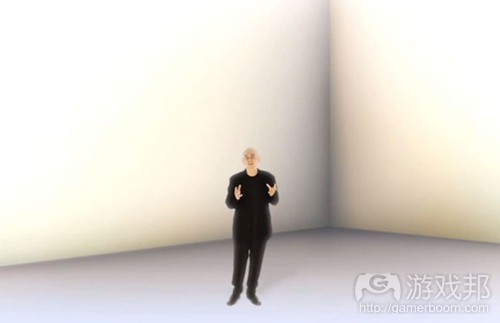阐述Peter Molyneux的“好奇心”实验意义
作者:Leigh Alexander
Peter Molyneux曾经告诉我,他并不在乎自己乘坐的飞机会不会坠毁,只要他能知道玩家对《Curiosity》的反应就够了。
因为苹果的反复无常,这个方块点击实验游戏比22cans计划的时间提前发布,Molyneux也因此不得不在龙卷风肆虐的某天从以色列飞返英国。在令人喘不过气来的电话采访里,他告诉我即使在飞机上禁止使用手机,他也坚持把手机贴在飞机窗上,冒着危险,只为看到《Curiosity》吸引到第一批玩家。
Molyneux做的事似乎也有完全不愤世嫉俗的,我猜那就是人们始终关注其作品的原因,尽管在《Black & White》和《Fable》夸下海口却没有兑现诺言时,他们自己明显地表现出冷嘲热讽的态度。
热闹的“Peter Molydeux”Twitter页面继续充当人们不知疲倦的乐观主义和通常隐秘的幻想庆典,因为它是他们的笑柄。最近,“Molydeux”又提出一些惊人的想法,例如,“如果你的同伴是一扇门会怎么样呢?你可以把他/她放在平面上,只能与门另一边的人交流呢?”。这些想法之所以吸引人,是因为它们一半是荒唐不稽的,另一半又是引人遐想的。这正是Molyneux本人的生动写照。
在《Curiosity》中,玩家们要合作起来剥掉大方块的表层。他们的集体任务就是抵达方块的中心,但里面还隐藏着一个个人任务:给第一个到达方块中心的人。据承诺,这个搬走最后一个方块碎片的人将得知一个未知的、神秘的、“改变一生的”秘密。
它也是一个赢利实验,无论那个“秘密”是否是营销噱头。玩家可以购买升级道具,以便使自己比其他人更快地破坏方块表面。之后,《Curiosity》允许玩家通过增加方块碎片,来拖延其他玩家的进度。只要玩家花钱,方块就会保持活力。
去年,Molyneux告诉我,能够观察社交行为(游戏邦注:如在方块的表面上写写画画),以及收集关于玩家沉浸感和消费的数据也是最令《Curiosity》开发团队感到兴奋的事。但愿22cans不久之后能公布那些数据,至于现在,关于方块中心的秘密在几天前才揭开神秘面纱。
方块的中心
当Molyneux将《Curiosity》的方块中心的奖励描述为“绝对的不可思议”时,他似乎是在传达他自己的创意、对数字媒体的挚爱和在制作实验中收获的乐趣。现在,实验结束了。虽然《Curiosity》的赢家有权保留秘密,但这位18岁的爱丁堡人Bryan Henderson——他下载该游戏后第一次登录游戏,1个小时后他成为最终赢家,选择了向全世界公开这个秘密(“他说过他会分享!!!!!!!!!”Molyneux通过Twitter发表了这句话,绝对不少于9个感叹号)。
不久之后, Henderson公布了他的奖励,那段通告视频广泛传播,其中,Molyneux被光环包围着,站在白色方块内部的中心。这种极简主义风格的表现法营造了一种超现实、后未来主义的氛围。所谓奖励的真相就是:能够主导22cans的“数字游戏大神”对下一款世界构建游戏《Godus》的设计,并分得其小部分收益。
我们能从这场“众人努力,一人得利”的游戏中得到什么启示?这就是开发团队所谓的“改变一生的秘密”吗?轻纪轻轻的Henderson能对靠Kickstarter融资的《Godus》产生多大影响?这对那些因为期望Molyneux的领导而慷慨解囊的人来说公平吗?另外,开发团队最近宣布当《Godus》从1.7万名赞助者(他们当中肯定有许多人打算预购)手中得到80万美元融资时,该游戏将在DeNA上发布免费手机版本。这个消息已经吊足玩家的胃口。
方块的中心到底是什么?Peter Molyneux。网上的抱怨声与喝彩声对半分。英国记者《Rock, Paper Shotgun》的Jim Rossignol在Twitter上说得好:“但可能那就是重点。Molyneux的狂想实验是一场表演。无论如何,Peter都会出现在游戏中。”
创意的构想
尽管把Molyneux当成漠然的自我陶醉者可能是不正确的。但在许多方面,游戏本身就是建立在理想主义、梦想和承诺之上的。所有游戏的销售都要依靠想象力和大肆宣传。Molyneux的工作是游戏文化元素中的精华:坚定不移的忠实、痛苦和认为游戏界把财政计划和赢利操纵当成核心任务的玩世不恭主义的平衡。他是创意的创造者,他对实验的渴望和热情反映在交互娱乐和创意分享的本质上。
他是学术圈的成员也是反对者。作家兼游戏设计师Ian Bogost的游戏《Cow Clicker》讽刺了Facebook游戏,与《Curiosity》类似——在这两款游戏中,设计师让许多人反复点击某个东西,看看会发生什么事。前者显然没有做出任何承诺,而后者则暗自拿整个世界作为承诺。
两款游戏都揭露了创作者及其玩家的动机。《Cow Clicker》积累了大量不计较设计师的意图和承诺,仍然花钱买乐趣的玩家,这让游戏的创造者大为惊讶;因为它表明,许多人只是被拥有一个数字物品的的概念所吸引,像禅宗信徒一样坚持不懈地点击着一头虚拟的牛。
“Molyneux做了一款比我的还无聊的点击游戏,真让我妒忌。”Bogost表示,“我认为《Curiosity》很了不起,能让人受启发。但那并不能缓和它的自私或无耻。”之后他又补充道,“《Curiosity》不是一场实验。实验只是一个修辞诡计,让玩家不会注意到它的真正意图是促销。”
好奇心和希望
人们可能会好奇Molyneux在《Curiosity》放入的个人动机是什么,以及玩家的反应是否让他感到惊讶或失望。尽管,我自己很难把一个满怀希望的、许下重大诺言的人当成隐秘的愤世嫉俗者——就像很难把Bogost当作暗自关心、乐观地对待玩家、对玩家充满好奇心的人(尽管他就是)。我更相信,Molyneux远非利用《Curiosity》剥削乐观主义的玩家、给《Godus》做促销或美化一份没薪水的实习工作(游戏邦注:这里指让《Curiosity》的最终赢家Henderson参与《Godus》的设计开发),相反地,他只是活在自己那个希望永存的小小世界里。
也许技术并非重点。我认为《Cow Clicker》也不一定是一场“实验”,而是价值观的宣言,并且它未必没有给Bogost带来任何好处,毕竟它意外地成为其知名作品。有没有可能,像Bogost一样,Molyneux只是利用了他自己并不喜欢的游戏系统来传播他自己在意的一个想法?
这两个基本上类似的游戏目标和玩家对其产生的反应完全被游戏制作者及其制作原因改变了;玩家期待什么和最终得到什么,才是这整个故事经过的启示。至少我是这么认为的。
不幸的是,游戏行业在商业和艺术、文化以及个人表达之间划了一条模糊的界线而陷入泥沼,令人失望和沮丧。另外,获得声名的往往是愤世嫉俗者。
那就是为什么我宁可选择相信Molyneux是出于纯粹的目的,将这场疯狂的实验当作个人表达对游戏领域看法的合法且必要的方式。如果《Curiosity》是价值观的宣言,那么可以说,好奇心和希望正是游戏的意义所在,幻想世界对某些人(虽然不是所有人)来说就像现实世界一样重要;所以,拥有一个创造的机会正是改变一生的奖励。
Bogost还说了一句话:“另外:所有人都欠Molyneux一声抱歉,因为这款游戏除了商业,剩下的部分是那么谦逊、那么容易被遗忘。”(本文为游戏邦/gamerboom.com编译,拒绝任何不保留版权的转载,如需转载请联系:游戏邦)
The Curiosity experiment, and the church of Peter Molyneux
By Leigh Alexander
My favorite story about Peter Molyneux has to do with the time he told me he didn’t care if his plane crashed or not, so long as he could know what was happening with Curiosity.
Because of Apple’s caprices, the cube-tapping experimental game had launched sooner than 22cans expected, and Molyneux had to rush back from Israel to the UK in a whirlwind. In a breathless phone interview, he told me about how even though flight regulations warn against seeking mobile signals in the air, he pressed his device against the plane window, damn the risk, just in case there’d be some way for him to see Curiosity’s initial flood of users.
There is something that appears to be profoundly uncynical about Molyneux, and I suspect that’s what keeps people paying attention to his work despite their own visible cynicism sowed since the days when Black & White and Fable made impossible promises, and simply delivered regular old flawed video games.
The jam-inspiring “Peter Molydeux” Twitter account continues to be as much a loving celebration of the man’s tireless optimism and often esoteric visions as it is a mockery of them. Recent ‘Molydeux’ ideas like “What if a door was your companion? You can place him/her on any surface and can only interact with others on the other side of the door?” are striking because they’re partially ridiculous, but there’s a fascinating seed therein. It’s a good analogue for Molyneux himself.
With Curiosity, mobile app users could access a massive cube (“quite a beautiful-looking cube,” an enthusiastic Molyneux told me once) and simply by tapping on it, collaborate to strip away its layers. The over-arching group quest was to reach the center of the cube, but therein was packed a quest for the individual: Be the first one to reach the cube’s center. The user to wick away the very last cubelet was promised to earn an unknown, mysterious, “life-changing” secret.
It was also by any estimation an experiment in monetization, whether or not that element was part of the sell. Users could pay for upgraded taps, the ability to destroy layers more quickly than their fellows. Later on, Curiosity enabled users to add cubelets, potentially reversing the progress of other players and keeping the cube alive if they spent money.
The ability to observe social behavior, like writing and drawing on the cube’s face, and to gather user data about engagement and expense, was part of what Molyneux told me last year was most exciting to his team about Curiosity. Hopefully 22cans will release that info soon, but for now, all talk is about the revelation at the cube’s center, which was unveiled just days ago.
Inside the cube
When Molyneux described the reward at the center of Curiosity’s cube as “amazing by any scale,” he sounded transported by his own creation, utterly in love with the digital medium and the joy of experimental creation. Now the experiment has ended. While Curiosity’s winner had the right to keep their secret, 18 year-old Bryan Henderson of Edinburgh — who completed the cube just about an hour after downloading the app and joining the game for the first time — chose to share his revelation with the rest of the world (“He has said he will share!!!!!!!!!” Molyneux enthused via Twitter with no fewer than nine exclamation points).
Shortly after Henderson claimed his prize, the announcement video circulated widely, featuring Molyneux haloed by light and standing at the center of a smooth white cube interior. The minimalism of the presentation gave it a surreal, retro-futurist air, like the Architect at the center of the Matrix. The facts of the prize: The ability to be the reigning “digital god” in 22cans’ upcoming world-builder Godus, and to share a slice of its profits.
Cue cynics — and their generally-reasonable reservations. What message can we gain from the efforts of many leading to a reward for one? Is a job on a dev team a “life-changing secret?” How much control will young Henderson have over Kickstarter-backed Godus, and is that fair to those who backed it expecting Molyneux’s leadership? Godus, incidentally, has confused its players enough already with the recent revelation that it’d have a free-to-play mobile release via DeNA after raising $800,000 from 17,000 backers, many of whom doubtless considered their donation a pre-order.
What was inside the cube? Peter Molyneux, in more than one sense. The internet’s grumbling sigh, equal parts unsurprised and fond, followed, amid the usual smattering of genuine irritation. UK journalist Jim Rossignol of Rock, Paper Shotgun put it quite well on Twitter: “But perhaps that’s the point. Molyneux’s hyperbolic invention is the show, now. The games will all have Peter inside, one way or another.”
A creature of ideas
To categorize Molyneux as a careless narcissist might be a misstep, though. In many ways gaming itself is founded on idealism, dreams and promises. All games are marketed on vision and hype. Molyneux’s work is the quintessence of that element of gaming culture: Unswerving faith, a counterweight to the bitterness and cynicism that assumes a financial agenda or a manipulative urge for profits at the core of every visionary. He is a creature of ideas, and his desire for experimentation and enthusiasm is the opportunity to reflect on the nature of interactive entertainment and participatory creation.
He has both a compatriot and an antithesis in academic, author and game designer Ian Bogost, whose Cow Clicker, a cynical critique of Facebook games, is in its own way kin to Curiosity — both games are about seeing what will happen when you ask a potentially-massive addressable audience to click on something repeatedly. The former game explicitly promised nothing, while the latter implicitly promised the world.
Both games are important demonstrations as regards the motivations of the creators and their players alike. Cow Clicker surprised its creator with a sea of devoted players who really didn’t care what he did to them, that he gave them nothing, and that he had fun at their expense; it surprised its creator with the revelation that many people were just attracted to the idea of owning a digital object, to the simple zen-like repetition of clicking on a cow.
“I’m jealous that [Molyneux] made a more boring clicking game than I did,” Bogost (predictably) snarked. “I also think Curiosity was brilliant and inspired. But that doesn’t make it any less selfish or brazen,” he later added, noting “Curiosity was *not* an experiment. Experiment’ is a rhetorical ruse meant to distract you from the fact that it’s promotional.”
Curiosity and hope
One can wonder endlessly about Molyneux’s private motivations for Curiosity, and whether his players’ reactions surprised or disappointed him. It’s still hard for me, though, to see the hopeful man with the big promises as a secret cynic — just as it’s hard to see Bogost as secretly caring, optimistic, curious about players (though he is). I’d much rather believe that, far from using Curiosity to exploit optimism, promote Godus or glamorize unpaid internships, Molyneux instead lives in his own luminous little world where hope springs eternal.
Maybe the mechanics aren’t the whole message. I think Cow Clicker wasn’t necessarily an “experiment” either, but a statement of values, and it wasn’t necessarily non-promotional, having inadvertently become Bogost’s most famous work. Isn’t it possible that, like Bogost, Molyneux used a system he didn’t like in and of itself to promote an idea he cared about?
The purpose and reception of two fundamentally similar games is completely altered by who made them and why; by what players expected versus what they got, which is the most important takeaway of this whole episode, for me.
The games industry, uncomfortably lumbering all over the muddy lines that separate business from art, culture and individual expression, is often disappointing and depressing, and cynicism is often well-earned.
That’s why it feels like an interesting choice to believe in Molyneux in a pure way, to embrace hyperbolic invention as a legitimate and necessary sentiment in the games landscape. If Curiosity is a statement of values, it says that curiosity and hope are meaningful to games, that imaginary worlds can be as momentous to someone, if not everyone, as real ones, and that the opportunity to create is a life-changing reward.
“Also: everyone’s an apologist for Molyneux because the rest of the games biz is so unambitious and forgettable,” says Bogost. “So there’s that.” (source:gamasutra)
上一篇:阐述游戏中两种类型的精通和评价










































 闽公网安备35020302001549号
闽公网安备35020302001549号